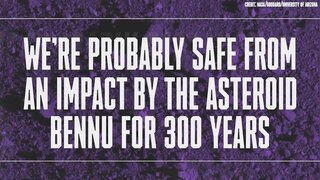Create a free profile to get unlimited access to exclusive videos, sweepstakes, and more!
Cancel Your Asteroid Insurance, Earth Declared Safe from Killer Asteroids for 1,000 Years
Feels like we should throw a party.

In the 2014 disaster flick Asteroid vs Earth (now streaming on Peacock!), humanity finds itself in the crosshairs of a killer wave of asteroids, with no way to stop them. It’s a nightmare scenario, and one humanity has been hard at work to prevent.
While the DART mission proved we could smack an asteroid out of the way if we needed to, scientists from the University of Colorado Boulder and NASA’s Jet Propulsion Laboratory (JPL) have determined there’s probably no need, at least for the next 1,000 years.
RELATED: Boom! DART Changed The Orbit Of Asteroid Dimorphos Even More Than We'd Hoped
Peace for a millennium sounds like the sort of thing you only get after making a deal with the devil — the Star Trek: The Next Generation episode “Devil’s Due” dealt with a similar premise, when the devil themself comes to collect on a bargain made with the peoples of Ventax II — but this is pure science, baby! The study is currently posted to the preprint ArXiv server and has been accepted for publication in The Astronomical Journal.
WHEN ASTEROIDS STRIKE
All of the time, literally. Every day, the Earth plays host to more than 100 tons of teeny tiny asteroid visitors, the size of dust or grains of sand. Those objects all burn up in the atmosphere, adding a little bit of extra material to the planet.
Larger objects are rarer, but they’re out there. Roughly once a year, we cross paths with an asteroid about the size of a car, and asteroids about 100 meters across slam into us every two thousand years or so. Impactors between that size and about a kilometer can do considerable local damage and cause loss of lives and infrastructure, but don’t threaten the species as a whole. Anything larger than that is bad news and potentially catastrophic, just ask the dinosaurs. Asteroids of that size crater the Earth every few million years, according to NASA.
The odds of any given day being the day a killer asteroid strikes are vanishingly small, but not zero. The solar system, like the future, is constantly in motion and every day is a new opportunity for disaster.
TRACKING ASTEROIDS AND PREDICTING IMPACTS
NASA’s asteroid watch team at the Center for Near Earth Object Studies (CNEOS) keeps a constant eye to the sky, looking for anything in the vicinity which might try and launch a sneak attack on our planet. To date, they’ve identified more than 30,000 impactors in total, the vast majority of which are too small to beat us in a fight.
Roughly one-third of the objects being tracked are more than 140 meters in diameter, not large enough to make humanity past tense, but plenty big for a bad day. Only 854, roughly 2.5%, are more than a kilometer wide. That’s a pretty normal distribution; any time you’re making a bunch of things (whether they are pancakes or asteroids) from the same pile of material, you’re likely to get very few large things and a lot of smaller ones. That’s good news for us because it means that species-killing impactors are relatively few in number.
Still, 854 are more than enough (you really only need one) and astronomers are still finding more. The catalog of near Earth objects is believed to be about 95% complete, with only a few dozen large impactors waiting to be discovered. That’s great because not only can we track the 854 potentially dangerous objects we’ve identified, but it also gives astronomers a near-complete population with which to make predictions about our overall risk.
Using their Sentry system, NASA scientists can run the orbits of known asteroids about a century into the future. That gives us a high degree of confidence that we’re not going to be hit in the short term, but things get a little wigglier on longer timescales. While asteroids are highly predictable, moving through the cosmos according to the laws of physics, each time they come into the inner solar system there’s a chance that interactions with planets and other cosmic objects will change their orbits down the line. With every additional orbit, things become a little less certain.
The new study uses a different method, focusing only on the portion of the orbit that brings an asteroid close to Earth. That allowed researchers to concentrate on moments of gravitational influence when the orbit might be altered. By modeling only the relevant portion of an orbit, scientists could use fewer computational resources and plot the trajectory further into the future.
Of all the asteroids they modeled, the one with the largest risk of impact was a kilometer-wide asteroid known as 1994 PC1. Over the next thousand years, the probability that 1994 PC1 will cross within the orbit of the Moon is a paltry 0.00151%, hardly worth worrying about. Of course, the risk of smaller asteroids causing local damage remains ever present, but we can probably stop searching the skies for something coming to wipe us out. At least for a little while.
Experience one of our worst nightmares vicariously in Asteroid vs Earth, streaming now on Peacock.



























